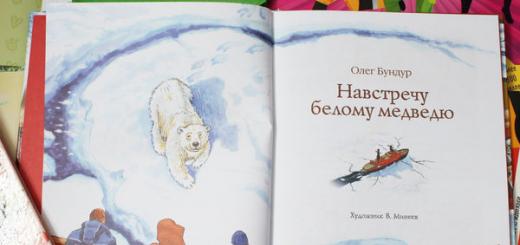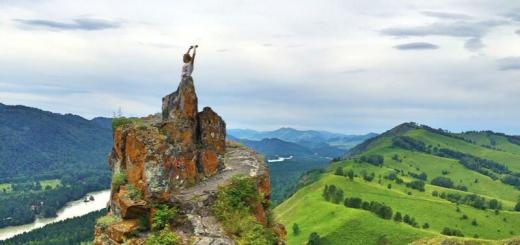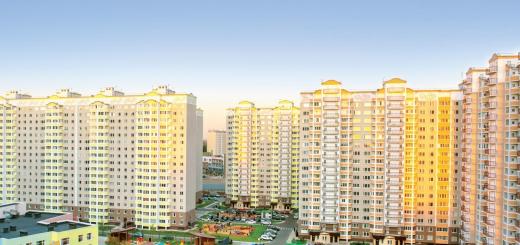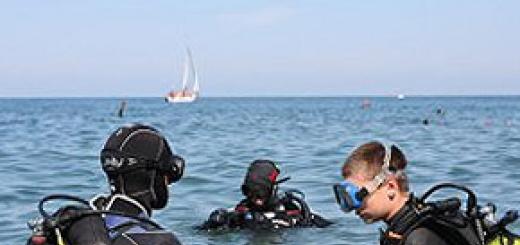A person who first came to the Argun Gorge, what he saw is impressive: from all sides mountains rise, in places densely overgrown with forest, from behind their peaks in good sunny weather the sugar heads of huge snow ridges peep out. To move here from one settlement to another, you have to repeatedly go up and down the winding mountain serpentine.
Sometimes you climb so high that the houses in the lowlands along the banks of the Argun seem very tiny. Riding at such heights is breathtaking every time. According to the military, who constantly make such high-altitude flights out of business, it is impossible to treat them without the slightest fear of a person who grew up on the plain. Especially in rainy weather, when everything is white around - from fog, and the driver sees only 3-4 meters ahead and the edge of the road to the side, behind which there is a cliff.
And when a combat vehicle stubbornly crawls along a track laid by tanks, washed out by the rain, swarming with one side on the rock, and with the other leaning heavily and sliding towards the abyss, you are not left for a second by the feeling of danger that these mountains conceal in themselves. wildlife these places, and not just people with weapons hiding in the local forests from just retribution.
Itum-Kale - a fortress of warriors
A military commandant's office appeared in Itum-Kala on February 25, 2000 - it was then that a reconnaissance squad arrived in this once settlement to prepare a place for receiving and accommodating the rest of the personnel.
The first thing that caught their eye was the ruins of the village. Broken and burnt houses were everywhere, charred skeletons of buildings with lonely chimneys sticking out. The smell of conflagration was mingled with the cadaveric stench of livestock buried under the rubble and decomposing. The riot of colors of the local nature, interspersed with traces of recent military events, made a rather depressing impression. The scouts even bitterly joked that now a correction must be made on the map: what used to be called the regional center is now designated as the ruins of Itum-Kale. There were no residents here at all: at the entrance they were met only by one local resident - an old man on a horse. He said that no more than 18 people remained in the village, mostly old men and women, almost all of the local population with the beginning of hostilities went to the mountains, and then to Georgia, where there are also Chechen villages. Before that, about 800 people lived in Itum-Kala.
It was decided to place the commandant's office in a house that suffered the least during the bombing and shelling, perhaps because it was located next to the mosque. She was not touched - the commander of the "South" group, Hero of Russia, Lieutenant General Ashurov, is a Muslim himself. According to the documents found in this house, from conversations with local residents, the scouts learned that its owner is the former Brigadier General of Dudayev - Akhmadov Said Ibragim, an Arab by nationality, who in 1996 nominated himself for the presidency of Ichkeria. Shortly before the arrival of Russian troops, Akhmadov fled to Georgia with his family, and his eldest son, one of the field commanders, was visiting Itum-Kala in December last year.
We are from intelligence
The scouts of the commandant's company arrived from the Kantemirovsk division, control officers from the Far East, signalmen from the Volga region. In addition to them, the Novosibirsk policemen of the temporary ROVD of the Itum-Kalinsky district were stationed nearby. According to private contract service Buev, the driver-mechanic of the BRDM, who was in Itum-Kala from the first day, the guys got close to the reconnaissance department, mostly combatants: many came from the KGB, the Ministry of Internal Affairs, four had previously served as scouts in the Airborne Forces.
The scouts do not differ in rank: either the senior sergeant or the corporal — all rank-and-file soldiers. There are 11 people in the unit, gathered from all over Russia: Lipetsk, Vladimir, Moscow - completely the middle band. Buev himself is from the Lipetsk region, he served as an urgent service in the autobath in the ZabVO, he is 38 years old, he went to Chechnya for financial reasons. And the rest went here, basically, for the same reason - many families, with work in the field tense. Those who are younger, the scout argues, maybe they wanted to experience new sensations - after all, there was some kind of change in the situation.
From the first days, the scouts, in cooperation with the police and border guards, carried out passport checks, carried out sweeping operations, identified weapons, covered the border guards when they negotiated with the commanders of the bandit formations, went to surrender their weapons. Of course, we also went on reconnaissance - we studied the approaches to strong points and other objects. During the sweeps, they covered the policemen, guarded them in case shelling starts from the mountains. It was necessary to free the slaves, some of them were in captivity for 15 years. Joint efforts of the soldiers of the commandant company and militiamen from Novosibirsk in the adjacent to Itum-Kale mountainous areas 15 slaves were freed.
At first they often shot here. During the day, silence usually reigned, but at night, it happened, twice raised on a military alert. Usually the fire was fired from small arms, and snipers were also beaten. It has become calmer since mid-April, but at first it was hard.
The most striking and tragic case in the so far short history of the Itum-Kalinsk commandant's office is the targeted sweep in Veduchi on March 30, 2000, when a field commander, Sharia security major, Mukhaev, was detained. Then Lance corporal Kolmozev was killed in a shootout, senior sergeant Khomyakov was wounded - both contract soldiers from the intelligence department, Muscovites. Their brave and decisive actions predetermined the success of the operation: one militant was killed, one mortally wounded, and outside the village, after the battle, a whole house-warehouse with ammunition was found and destroyed.
According to intelligence officer Lieutenant Colonel Shchukin, the soldiers of the commandant's office also had a difficult time because the police did not know how to fight properly. In Itum-Kala, the temporary ROVD has been operating since March 19, 2000 and has all the structures relying on it, which are doing their job well. These are the criminal investigation department, the passport office, the traffic police, and other specific services. But these units are not capable of fighting, they are not trained. Therefore, a situation arises, the lieutenant colonel complains, when 5 scouts cover 70 militiamen. There is not enough SOBR or OMON - units that are more or less prepared for combat.
Bandit tricks
Since the militants, after the appearance of army units in the Itum-Kalinsky region, began to bury and hide weapons and ammunition near the places of their subsequent use, the scouts constantly had to look for and destroy these caches. Until mid-April, almost every day, the military and police found large and small arsenals and warehouses in caves, in vegetable gardens, in abandoned houses. In caves, as a rule, grenades are placed on stretchers - on a combat platoon.
In the Itum-Kalinsky District Department of Internal Affairs, through the efforts of its chief, Colonel Yakovlev, they even created a museum of weapons seized during the sweeps and found weapons: machine guns, machine guns, grenade launchers, rifles from the beginning of this century, guns from the time of General Yermolov, as well as various homemade devices for murder. Arranging caches, the militants go to all sorts of tricks. For example, at the beginning of April, in the area of the settlement of Zona, 2 mortars and ammunition for them were found in a crater from an aerial bomb under a rag covered with earth. And at the cemetery in the Shatoi area, RPG-7, RPG-26, shells for BM-21 "Grad", anti-tank mines were removed from five graves.
With the local population, as the intelligence officers note, now there is a more trusting relationship than at the beginning - immediately after the militants left for the mountains. The soldiers of the commandant's office are delivering humanitarian aid, and the payment of pensions and child benefits has begun. Only employees of budgetary organizations - education, health care, local administrations - receive salaries, since almost the entire population of the district works only in their own farms.
According to Captain Ditkovsky, assistant chief of staff for financial and economic work and auditor, there are no special problems in the interaction of local authorities and the commandant's office. However, there are difficulties of a different kind - in the provision of stationery, office equipment.
At the same time, although humanitarian aid is sent out in a targeted manner - according to the number of registered residents, it does not always remain with those to whom it is directly intended. In late April, in one of the bandit mountain caches, this very "humanitarian aid" was discovered, and in addition to food - tents, a surveillance device, ammunition, a medal "For the Defense of Grozny", photographs of militants. Apparently, some part of the region's population supports the bandit formations: someone willingly, someone out of fear. The latter is not accidental. According to the scouts, many militants bear such animal nicknames as the Wolf, Doberman, lead not a human, but a real animal way of life in the mountains.
Information is also a weapon ...
Therefore, one of the main tasks of the Itum-Kalinsk commandant's office is to provide information to the local population and troops. The military commandant, Colonel Doschechnikov, and other officers of the commandant's office personally conduct explanatory and preventive conversations with the Chechens, bring to the attention of the self-government bodies and villagers orders and orders concerning life issues.
It cannot be said that the people who serve in Itum-Kala are completely cut off from the outside world, but they receive any news information there either in a very small volume - exclusively through listening to the radio broadcasts of the local radio station "Free Chechnya" for one hour in the morning, or one of the few newspapers that are delivered by helicopter with a week's delay. For these reasons, special hopes in Itum-Kala are pinned on the speedy restoration of the TV broadcaster destroyed during the hostilities, thanks to which not only the military, but also civilians will be aware of the events taking place both in the Chechen Republic itself and abroad.
It is possible that all these efforts will eventually be crowned with success, and the long-awaited changes for the better will also come in the Itum-Kalinsky region - the place of the latest melting of mountain snows in Chechnya.
Itum-Kale- a village, a regional center in the Republic of Chechnya; located in the valley of the Argun river. It is translated from Chechen as “settlement of Eton”. The Vainakh name of the village is Eton-Khelli. In the old days, there were many battle and residential towers here; on the eastern outskirts of the village there is a burial ground of the pagan period (Phyakochura keshnash)
This dictionary entry describes how the origin of the name can be explained or translated into Russian Itum-Kale... This decoding (explanation) of this toponym is given according to the book by A.V. Solid "Toponymic Dictionary of the Caucasus".
There are possible, and even likely to be, typos and inaccuracies caused by both scanning and post-processing. Alone all of them "catch" the strength is not enough, but you can - I will fix it. Also, due to the fact that this collection of dictionary entries contains books by several authors, different interpretations of the same name are possible - this is normal - the truth is born in a dispute. I would be grateful for the sent additions, clarifications and other works on toponymy
Comments:
Message from: pobeda202010Itum-kale, translated from the Turkic ITUM-dog, Kale-city. when the great conqueror Timur came to the Caucasus, the mountaineers of this settlement resisted for a long time and did not surrender, then he ordered to demolish this ITUM-kale "Dog's city"
Message from: Borz
Hya nen bud boo Fucking bitch dog. Itum-Kale means Eton-Khal "the village of Eton".
Message from: Galga
IT is 10
UM community (religious)
KHELLA-spawned.
ITUM-KALA - 10 communities (virds) that gave birth to.
Phyakochura keshnash
N (pu) offspring
AK-Idolly AKOCH-Idols
URA (OPA) -ORDAN (OR-GA river ARGUN, literally-ORDAN tree)
KESHNASH-graves
About ITUM - a dog. ITILIAN COMMUNITIES (Volga communities) Türks called "dog", however, like GA-URY or GYA-ORY literally - "ORDAN tree")
Message from: Said
The word Kale in translation from the Turkic means a castle (fortress)
Assalam Aleikum!
I bring to your attention the photos taken during a trip along the mountain route Grozny-> Shatoi-> Itum-Kali-> Khacharoi-> I lead chi. It is along this route (as conceived by the organizers of the construction of the Veduchi ski resort) tourists who will not be able to afford a helicopter will pass by :-)
Before reaching Shatoi, on the side of the road, springs with spring water that are unlike each other in taste are gushing in a row. The most popular and delicious water flows from this spring:
Shatoi did not take pictures, since you saw his panorama in previous posts, so I’ll go straight to Itum-Kali:
Itum-Kali is mainly inhabited by representatives of the Ch1antiy teip, who are distinguished by their tall stature, red hair and light eye color. On the southern outskirts of the village are the ancient ruins of the old aul. Since 1967, the Argun Historical and Archaeological Museum-Reserve has been operating here. At the beginning of April 2011, in the entire history of the existence of this mountain village, gas was supplied here. Natives of Itum-Kali are: Hero of Russia Magomed Uzuev (his name is the border post stationed here), who died together with A-Kh. Kadyrov Khusein Isaev, Chairman of the State Council of Chechnya, as well as Russian banker Abubakar Arsamakov
From Itum-Kali, upstream of the Orga (Argun) river, there is a road to Georgia, which was actively built under Maskhadov and which has now been frozen (part of the "Georgian" road is visible on the right):
We took to the left of the Georgian road and went up:
Towards Veduchi:
Veduchi, a small mountain village belonging to the numerous teip Khachara (Khacharoi), from which they come from: businessman: Ruslan Baysarov, the mayor of Grozny Muslim Khuchiev and my friend and just a good guy Alan Magomadov :-). As we saw, in Veduchi itself, the construction of a ski resort for $ 500 million is not being carried out, but according to the words local residents construction sites go "in-he is there!":
As I later understood, the construction will go from the other side.
Pay attention to the ruins of a village with a tower standing by the cliff, where people somehow restored their dwellings and live in them:
It is very difficult to live in the mountains, there is practically no money and people earn their living thanks to: beekeeping (excellent honey), maintenance of subsidiary plots, cattle breeding. But you forget about all the difficulties when you see such beauty around you, clean air and amazing spring water from glaciers:
Those who have the opportunity to build houses on their ancestral lands using natural stone:
At the very "end of geography" there are the ruins of the village of Ati-Bov (Ati-B1ovda) this is the small homeland of the Chechen blogger wild_che
At this point the journey was over, the next trip was planned to Hildehara and Shara ...
P.S. I ask professionals not to judge strictly for the quality of the photos, the photos are for informational purposes only.
Photo sketches from a trip to the mountains of the Itum-Kalinsky region of Chechnya, the southernmost in the republic and rich in historical and natural monuments. In an ordinary car, prior with the Ingush flag), with license plates near Moscow, we visited the construction site of the Veduchi ski resort; drove almost to the border with Georgia, to one of the largest necropolis in the North Caucasus, Tsoi-Pede, several times spent the night in a tent under the Milky Way; and also examined some of the battle towers, which are available to any tourist who decides to independently familiarize themselves with the nature of the Chechen Republic. Now there are no difficulties and dangers with this, which is proved by our bersaev experience:)

Before the start of the photo story - a map of the area, so that the scale of trips is better understood. By car, you can drive from Shatoi to Itum-Kale, then either turn towards Sharoi, passing Tazbichi, or go towards Veduchi, or, after passing the border post, go towards Tsoi-Pede.

1. The first place where tourists who come to the Itum-Kalinsky region stop are the Ushkaloyskie towers. One tower was destroyed to its foundations in 1944, the second was damaged in 2001, both were restored in 2011.

2. Once we drove in the evening and filmed the towers, illuminated by car headlights, against the background of the Milky Way.

3. In Itum-Kale, the administrative center of the district, there is a local history museum named after Khusein Isaev, located in the Pakoch castle. I was already there in 2012, so on this trip I took only a picture from the road.

4. The village of Veduchi. In a couple of years, it is planned to build a large modern ski resort... Currently, it is being brought transport infrastructure and we can enjoy the still untouched nature:

5. The restored tower in Veduchi, in the background is an ordinary village mosque. We spent the night in it on the first day of the trip (when we got to the village at night and could not find a place for a tent). Mosques in Chechnya are not closed at night, any traveler can stay there.

6. View from the village to the neighboring slope, there are planned ski slopes.

7. I think there are a lot of people here who want to build a summer cottage with a mountain view)



10. One of the gorges in the Veduchi area. We went down to this river.

11. You can wade across the river by car, or walk across the bridge (I like these))

12. The rest of the day we spent in the area of this mountain stream.

13. The other day we drove towards Georgia, to the Tsoi-Pede necropolis. View from the village of Tazbichi to the road that leads there.

14. Route along the Argun River (Chanty-Argun).

15. In the depths on the hill you can see the ruins of the tower, Kirda, it was damaged during the last military campaign.

16. A few kilometers from the border with Georgia, at the confluence of the Meshekhi River (left) and Argun (right), there is a rocky ridge with the Tsoi-Pede necropolis, on the southern edge of which there is a battle tower.

17. Like Vovnushki in Ingushetia, the tower stands on the very edge of a cliff, and is striking in the complexity of its construction. In the lower part, it is fastened with metal brackets, which prevent its destruction - the tower needs repair.

18. The weather began to deteriorate, we did not climb to the Tsoi-Pede necropolis, but decided to climb higher, to the abandoned auls above it. This is the view from Kamalha.

19. In mountainous Chechnya, I was amazed by the abundance of agricultural terraces - it was a lot of work to create them at such a height.

20. Road to Georgia, to Shatili. Below is a frontier post, which cannot be photographed.

21-22. Tsoi-Pede necropolis, view from above. There are over 40 tombs here - solar burial grounds, some of which are more than 10 centuries old.


23. We went up to the village of Korotakh.

24. A few years ago there was a battle tower, now it has collapsed.

25-26. Solar burial grounds.

26. Mountainous Ingushetia is 12 km away. I hope someday I will be able to walk from here to the Ingush village of Gul, the first from the border.

Downpour began and we returned back.
27. The third, the last part of our campaign took place in the Tazbichi area, where there are several battle towers. We spent the night under a tree, sheltered from the rain.

28. In the morning, they began to shoot the Etkala combat tower.

29. It was restored in 2012.

30. Deer battle towers.

31. You can climb into the lower one.

32. It is more difficult to get close to the top.

33. This is how it looks from above, on the slope of the Khacharoi-duk ridge.

34. Let me remind you, on the other side of the ridge - Veduchi.

35. Haskalinskaya battle tower, the oldest in these places, construction of 10-12 centuries.

36. The near corner collapsed and was promptly, but roughly rebuilt.

37. Views of the surroundings in the area of the tower. If I had my way, I would have moved to live in such places!)




41. From the village of Tazbichi there is a direct road to Sharoi, which we drove by car.

42. Sunset over Itum-Kali is filmed by a wonderful guy Abdullah Bersaev bersaev which I talked about earlier.


44. Haskalinskaya battle tower at sunset.

45. Somewhere in the depths of the mountains - Ingushetia :)


47. Here, at an altitude of 1500 meters, we made a lodging for the night. The Internet works in these places, I posted this photo on Instagram right from our tent, it got a record number of likes))

In the morning we moved to Sharoi, but I will write about this some other time. And from Itum-Kalinsky district, I showed only a fifth of the photos taken, sometimes not the most beautiful, but characteristic, so that one could form an opinion about these wonderful places. In 2015, I hope I will return here for a longer period, so that I have the opportunity to see in detail all the sights of the area and make photo reports on them. Thank you for your attention:)
My previous photo reports from the Chechen Republic:
| | |
In the Itum-Kalinsky region of the Chechen Republic, on February 19, the temporary department of internal affairs was replaced. Novosibirsk militiamen - the fourth batch over the past year - handed over their property and affairs to their replacements - employees of the Krasnoyarsk militia. The progress of replacing the personnel of the regional department was controlled by the heads of the GUVD Novosibirsk region and the Krasnoyarsk Territory.
For a whole year, employees of the Novosibirsk police carried out a combat watch in the southern region of the rebellious republic. Control over 15 settlements of the region, which occupies about 900 square kilometers of mountainous terrain, capricious weather conditions, to which Siberians are hard to get used to - and all this in conditions as close as possible to combat. The policemen changed each other four times. 300 people were sent to Itum-Kale every three months in order to suppress crimes, identify militants, caches with weapons, and repel bandits' attacks. We started from scratch. They built a regional department, premises for detainees, barracks, dug pillboxes and fortifications. It is no coincidence that during a visit to the Itum-Kalinsky District, the Minister of Internal Affairs of Russia V. Rushailo called this VOVD the best in the Chechen Republic.
| Weapons taken from the bandits |
And how many activities were carried out to clean up settlements how many crimes the criminal investigation officers, the department for combating illicit drug trafficking, district police officers, and passport service officers managed to uncover - defies description. Already on the eve of sending home the last batch of militiamen discovered three caches of militants at once, which contained Kalashnikov assault rifles and machine guns, 150-mm shells, cartridges and grenades.
Police Major Anatoly Vyatkin and Police Chief Andrey Bolle took their last battle near the village of Mulkoy in one of the tracts in the south of the Argun Gorge. To call this place disastrous is to say nothing. A year ago, these areas were liberated by Russian paratroopers with huge losses. The leaders of the Chechen fighters have repeatedly called Itum-Kale a stronghold of resistance and declared that the Russians will never be here. The citizens of Novosibirsk have radically changed this opinion. Leaving for their homeland, our guys handed over to their replacements a well-built and equipped regional department, an established system of defense and interaction. And, most importantly, the good attitude of the locals, who finally believed in the existence of Law and Order. The residents of Novosibirsk also left behind a mourning reminder of the killed employees: now there is an obelisk not far from the place of the battle where the guys died. On February 14, in memory of the fallen comrades, employees of the temporary police department opened a memorial stele. On the highest plateau between the villages of Gukhoy and Mulka, there is a white obelisk with the names of Anatoly Vyatkin, Andrei Bolle and Andrei Kravchuk, a scout who died in the same battle. The opening ceremony of the stele and the mourning meeting were also attended by the heads of the regional police department, headed by the chief, who arrived at the regional center to withdraw a detachment of the Novosibirsk police. The names of the militiamen are now permanently included in the lists of the personnel of the Itum-Kalinsky department of internal affairs. On February 19, the train on which the Novosibirsk policemen would return to their homeland left Mozdok. His arrival in Novosibirsk is expected on Saturday.










